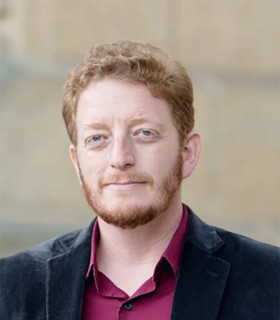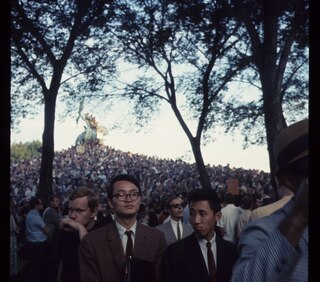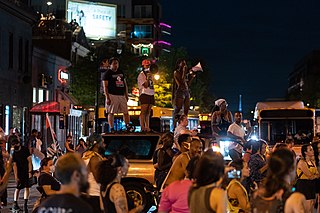The 1968 Democratic National Convention was held August 26–29 at the International Amphitheatre in Chicago, Illinois, United States. Earlier that year incumbent President Lyndon B. Johnson had announced he would not seek reelection, thus making the purpose of the convention to select a new presidential nominee for the Democratic Party. The keynote speaker was Senator Daniel Inouye (D-Hawaii). Vice President Hubert H. Humphrey and Senator Edmund S. Muskie of Maine were nominated for president and vice president, respectively. The most contentious issues of the convention were the continuing American military involvement in the Vietnam War and voting reform, particularly expanding the right to vote for draft-age soldiers who were unable to vote as the voting age was 21. The convention also marked a turning point where previously idle groups such as youth and minorities became more involved in politics and voting.

A black bloc is a tactic used by protesters who wear black clothing, ski masks, scarves, sunglasses, motorcycle helmets with padding, or other face-concealing and face-protecting items. The clothing is used to conceal wearers' identities and hinder criminal prosecution by making it difficult to distinguish between participants. It is also used to protect their faces and eyes from pepper spray, which is used by police during protests or civil unrest. The tactic allows the group to appear as one large unified mass. Black bloc participants are often associated with anarchism, anarcho-communism, communism, libertarian socialism and the anti-globalization movement.

The 1999 Seattle WTO protests, sometimes referred to as the Battle of Seattle, were a series of protests surrounding the WTO Ministerial Conference of 1999, when members of the World Trade Organization (WTO) convened at the Washington State Convention and Trade Center in Seattle, Washington on November 30, 1999. The Conference was to be the launch of a new millennial round of trade negotiations.

Riot control measures are used by law enforcement, military, paramilitary or security forces to control, disperse, and arrest people who are involved in a riot, unlawful demonstration or unlawful protest.
An agent provocateur is a person who commits or who acts to entice another person to commit an illegal or rash act or falsely implicate them in partaking in an illegal act, so as to ruin the reputation or entice legal action against the target or a group they belong to or are perceived to belong to. They may target any group, such as a peaceful protest or demonstration, a union, a political party or a company.

2004 Republican National Convention protest activity includes the broad range of marches, rallies, performances, demonstrations, exhibits, and acts of civil disobedience in New York City to protest the 2004 Republican National Convention and the nomination of President George W. Bush for the 2004 U.S. presidential election.
The Gainesville Eight were a group of anti-Vietnam War activists indicted on charges of conspiracy to disrupt the 1972 Republican National Convention in Miami Beach, Florida. All eight defendants were acquitted.

The January 20, 2005 counter-inaugural protests were a number of demonstrations, held in Washington, D.C., and other American cities to protest the second inauguration of U.S. President George W. Bush.
Security culture is a set of practices used by activists, notably contemporary anarchists, to avoid, or mitigate the effects of, police surveillance and harassment and state control.
John Francis Timoney was an American policeman and law enforcement executive. He served as Chief of the Miami Police Department from 2003 to 2010. He was previously Commissioner of the Philadelphia Police Department (1998–2002) and held a variety of positions with the New York Police Department (1967–96), including its Chief of Department and First Deputy Commissioner. He worked for the Ministry of the Interior of Bahrain as a police consultant. Timoney drew both international praise and criticism for his handling of mass protests.

A political demonstration is an action by a mass group or collection of groups of people in favor of a political or other cause or people partaking in a protest against a cause of concern; it often consists of walking in a mass march formation and either beginning with or meeting at a designated endpoint, or rally, to hear speakers. It is different from mass meeting.

Ben Manski is an American sociologist, lawyer, and democracy advocate. He teaches as an Assistant Professor of Sociology at George Mason University after earning his PhD in sociology from the University of California, Santa Barbara. Manski's work focuses primarily on social movements, democratization, and constitutionalism. He is the founder of the Liberty Tree Foundation for the Democratic Revolution, and co-founder of Move to Amend, the 180/Movement for Democracy and Education, and United for Peace and Justice. In 2011, he chaired the first biennial "Democracy Convention."
Pittsburgh Organizing Group, often referred to as POG, was a Pittsburgh, Pennsylvania-based anarchist organization concerned with anti-militarism, social and economic justice, labor solidarity and police brutality issues locally, nationally, and internationally. POG was formed in 2002, and since then it has been responsible for the most persistent local protests against the Iraq War and claims to be one of the largest radical groups in Pittsburgh. The group has organized protests, pickets, vigils, direct actions, street theatre, concerts, teach-ins, conferences, and rallies. Some of its events have been overtly confrontational and disruptive. More than 122 people have been arrested at POG organized direct actions, and some events have involved direct confrontation with the police. POG is an affiliate group of the Northeast Anarchist Network.

Protest activity against the Vietnam War took place prior to and during the 1968 Democratic National Convention.

October Rebellion was the collective name for the series of protest events surrounding the fall 2007 meetings of the World Bank and International Monetary Fund on October 19 – 20, 2007, in Washington, D.C., United States. The events were organized by the October Coalition. According to the October Coalition's call to action, the group demanded an end to all third world debt using the financial institutions' own resources, the end to structural adjustment policies believed to prioritize profit over the lives of individuals, and an end to social and environmental issues caused by oil and gas production, mining, and certain kinds of infrastructure development.

Kettling is a police tactic for controlling large crowds during demonstrations or protests. It involves the formation of large cordons of police officers who then move to contain a crowd within a limited area. Protesters either leave through an exit controlled by the police, leave through an uncontrolled gap in the cordons, or are contained, prevented from leaving, and arrested.

The Little Steel strike was a 1937 labor strike by the Congress of Industrial Organizations (CIO) and its branch the Steel Workers Organizing Committee (SWOC), against a number of smaller steel producing companies, principally Republic Steel, Inland Steel, and Youngstown Sheet and Tube Company. The strike affected a total of thirty different mills belonging to the three companies, which employed 80,000 workers. The strike, which was one of the most violent labor disputes of the 1930s, ended without the strikers achieving their principal goal, recognition by the companies of the union as the bargaining agent for the workers.
Camilo Viveiros is an American political activist.

A mobile field force (MFF), within the context of United States law enforcement, is a large element of police officers specially organized to support anti-riot operations through the use of maneuver tactics aimed at dispersing crowds during their embryonic phase or extracting agitators and leaders from larger groups. The mobile field force concept was created by the Miami-Dade Police Department in the 1980s.

Civil unrest began in the Uptown district of the U.S. city of Minneapolis on June 3, 2021, as a reaction to news reports that law enforcement officers had killed a wanted suspect during an arrest. The law enforcement killing occurred atop a parking ramp near West Lake Street and Girard Avenue. Police fired several rounds, killing the person at the scene. In an initial statement about the encounter, the U.S. Marshals Service alleged that a person failed to comply with arresting officers and produced a gun. Crowds gathered on West Lake Street near the parking ramp soon afterwards as few details were known about the incident or the deceased person, who was later identified as Winston Boogie Smith, a 32-year-old black American man.














